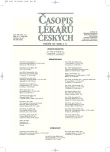-
Medical journals
- Career
Our First Experience with CT Enteroclysis
Authors: Hana Malíková; B. Míková
Authors‘ workplace: Radiodiagnostické oddělení Nemocnice Na Homolce, Praha
Published in: Čas. Lék. čes. 2006; 145: 879-883
Category: Original Article
Overview
Background.
Small intestine belongs to abdominal organs which are difficult to imagine. Methods of examination have therefore continuously improved in order to get better picture of the intestine.Methods and Results.
CT enteroclysis represents a modern method of the small intestine imagining which combines classical enteroclysis with spiral abdominal CT. Small intestine is filled with negative contrast material applied by an enteric tube. The negative contrast material optimises visualisation of the intestinal wall, namely after the enhancement using iodine intravenous contrast. Within 23 months we examined 33 patients with gastroenterological indication using CT enteroclysis. In 31 cases results were technically satisfactory, small intestine was well filled by the negative contrast material and sufficiently distended. According to clinical indications patients were classified into four groups. Group A: 10 patients with problematic indications. No pathological changes were found in this group. Group B: 8 patients suspected of Crohn’s disease. Only two cases were negative in this group. In 6 cases signs of inflammation in the small or large intestine were found. Group C: 6 patients after the surgical treatment of Crohn’s disease, suspected of the recurrence. All patients had signs of the recurrence. Group D: 7 patients with various clinical diagnoses. Examination was in 2 cases negative, in other 5 cases some pathological changes of the intestine were found: 1case of malabsorption, 3 cases of adhesion and hernia, 1 case of intestinal inflammation with covered perforation and inter-intestinal abscess.Conclusions.
CT enteroclysis was confirmed to be effective method for high quality imaging of the small intestine with associated tissues and the whole abdominal cavity. However, it is a method with represent irradiation, stress of intravenous administration of the contrast material and the discomfort related to enteric tube. Examination should not be indicated in cases of the problematic diagnosis only. However, in cases of correct indication signs of pathology were frequently confirmed.Key words:
CT enteroclysis, Crohn’s disease, iodine intravenous contrast.
Labels
Addictology Allergology and clinical immunology Angiology Audiology Clinical biochemistry Dermatology & STDs Paediatric gastroenterology Paediatric surgery Paediatric cardiology Paediatric neurology Paediatric ENT Paediatric psychiatry Paediatric rheumatology Diabetology Pharmacy Vascular surgery Pain management Dental Hygienist
Article was published inJournal of Czech Physicians

-
All articles in this issue
- Nicotinic Acid: An Unjustly Neglected Remedy
- New Tobacco Dependence Pharmacotherapy: Varenicline, Parcial Agonist of α4ß2 Acetylcholin-nicotine Receptors
- Pigmented Tumors of the Skin and Anoikis
- Contemporary Non-invasive Aesthetic Medicine
- Carboxytherapy – A New Non-invasive Method in Aesthetic Medicine
- Sulcus Nervi Dorsalis Penis/Clitoridis: Clinical and Forensic Aspects
- Diagnostics and Indications of Surgical Treatment of Patients with Lung Carcinoma at the First Clinic of TRN of the First Faculty of Medicine and the VFN Prague in Years 2004 to 2005
- Molecular Genetic Characterization of Chronic Lymphocytic Leukemia Aggressivity in Czech Patients: A Nucleotide Variability of Genes Coding for Heavy Chain of Immunoglobulin
- Adiponectin and Insulin Sensitivity
- Multidisciplinary Use of Contrast Sensitivity
- Mean Platelet Volume (MPV) in Crohn’s Disease Patients
- Colorectal Cancer – Short Time Results of Laparoscopic Resection in 350 Patients
- Our First Experience with CT Enteroclysis
- Comments to Statistical Methods in Medical Disciplines
- Journal of Czech Physicians
- Journal archive
- Current issue
- Online only
- About the journal
Most read in this issue- Nicotinic Acid: An Unjustly Neglected Remedy
- Mean Platelet Volume (MPV) in Crohn’s Disease Patients
- Our First Experience with CT Enteroclysis
- Contemporary Non-invasive Aesthetic Medicine
Login#ADS_BOTTOM_SCRIPTS#Forgotten passwordEnter the email address that you registered with. We will send you instructions on how to set a new password.
- Career

